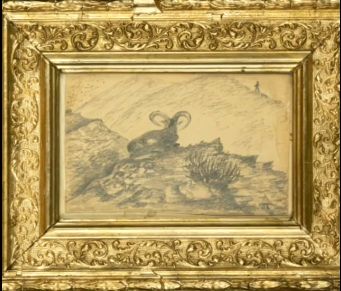Nasser al-Din Shah was the first Iranian king to head to the new Europe to visit Western civilization and technology at the head of the governing body, and after that, during his reign, several changes took place in various fields. From the printing of the first banknote and the establishment of the first national museum to the arrival of photography and the establishment of the Academy of Dar-ol-fonoun (siences) took place during this period.
After reaching the kingdom, Nasser al-Din Shah sent a number of painters outside Iran to learn European painting and be able to teach it in Iran. At the same time, he studied painting and drawing again and under the supervision of Abul Hassan Khan Sani Al-Molk, he studied drawing and painting, and in the works left by him, the influence of Abul Hassan Khan's painting style can be clearly seen. Nasser al-Din Shah painted the faces of ministers, courtiers, and ambassadors and inside he painted the faces of women, maids and eunuchs.

A collection of Naser al-Din Shah's works is kept in Golestan Palace, and now in a virtual display on the Instagram page of the Golestan Palace World Heritage Site, a number of them have been exposed to the public, some of which have been shown to the public for the first time.

Nasser al-Din Shah, based on the Western attitude and the realistic view that entered Iranian art at that time, left behind paintings and designs that are characterized by naturalism.Portraits, figures, animals, landscapes, etc. Although weak with a realistic look, the painter has made every effort to be as similar as possible to the subject and to keep the proportions as much as possible.

Naser al-Din Shah used metal and ink pens in his design and watercolors and oil paints in his paintings. The introduction of the person from whom it is designed, the relevant place, time or description of an event can be seen in these works.

Reading the short descriptions he wrote of his works, we realize that design was not a recreational work, but a part of the king's daily life, and the tools were always available to him so that he could design in any situation. Once in the hunting ground, the rams that were killed were the subject of his drawing, and another time, in the last hours of the night, he drew a plan on paper. For this reason, many of these designs have been formed very quickly and in small dimensions.

Although most of Nasser al-Din Shah's designs are realistic, there are also works of the mind. The "dream" painting depicts creatures with animal bodies whose heads have become tall cylinders. One of the remarkable works of this collection is the map of Markazi province, which was drawn after the Shah's return from Arak. Dots are marked in red on this map, and the note, written in the same way as other Shah's works in the margins of the paper, is gilded and of special importance.

The last painting of Naser al-Din Shah, which remained unfinished after his assassination, can also be seen in this virtual exhibition. A landscape that was painted in oil in 1313 AH and in which a wide plain with several moving trees and horses can be seen. The substructure of this work was done and its composition was determined, but Nasser al-Din Shah did not have the opportunity to complete the work and draw the details.

By Dorsa Bakhshandegi

